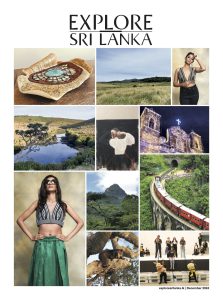Ancient cultures around the globe are rich in curious tales about the wisdom, the wit and the power of fascinating half- humans and beautiful yet intriguing creatures. Myths and mythical creatures have left their mysterious signatures in Sri Lankan art and literature, especially during the Kandyan era.
By Chamindra Warusawitharane Photography by Hiranya Malwatta
The King’s eyes fell upon a wonderful sight. The two were engrossed by each other and oblivious to the rest of the world. Their faces and busts depicted perfect human beauty while they were covered in delicate brown feathers from waist below, supported by two pairs of legs that could have belonged to a couple of ostriches. The beautiful female danced her ethereal dance while her equally stunning mate played his flute. These creatures are known as ‘Chanda Kinnera’, which literally translates as ‘Moon maids and men’, the land inhibiting counterparts of mermaids and mermen. According to legend, they lived deep in the woods and loved music and dance. Smitten by the beauty of the ‘Moon maid’, the King shot an arrow through her mate’s heart. The maiden fell upon her mate, uttered a heart-piercing lament and rejected the King’s advances. Deeply moved by her sorrow, God Sakra sprinkled water on the dead body and brought her mate back to life. Thus goes a Buddhist tale that Sri Lankans have adopted and welcomed into their literature, art and theatre over the centuries.
Not only art but also religion has been influenced to some extent by mythical creatures and their stories. As you enter certain Buddhist temples you can witness midget-like creatures at the foot of the building that are depicted as holding up the whole structure. These are called ‘Vamana’ and their stories vary. To some the ‘Vamana’ are those who have sinned in their past lives and are therefore eternally condemned to bear the weight of the building that they seem to be carrying. However, another story claims that these are servants of the ‘Kuvera’, who is always associated with opulence. These two servants are known as ‘Sankahanidi’ and ‘Padmanidi’ and their carved images radiate a cheerful lightheartedness that is lacking in other ‘Vamana’ images.
The fire-breathing, world famous dragons are not absent from Sri Lanka’s list of mythical creatures. Dragon arcs built at the entrance of Buddhist temples are designed to create a sense of awe. An elephant’s trunk, a pig’s ears, a fish’s body, a bird’ s beautiful tail and a lion’s limbs make up the mythical dragon in Sri Lanka.
If dragons are the brave warriors of the sea, lions are their counterparts on land. The legendary forefather of Sri Lankans is a man who has the strength and the will of a lion. Therefore, unsurprisingly Sri Lankan mythology is scattered with various representations of lion like mythical creatures. ‘Narasingha’, which translates as human-lion is a fascinating person. Its human head bears a pair of perfectly shaped eyes, lustrous hair and two fangs. Its body resembles that of a lion and it can also breathe fire. ‘Narasinghe’, is believed to represent good. ‘Gajasinghe’ has an elephant’s head and a lion’s body.
To some the ‘Vamana’ are those who have sinned in their past lives and therefore are eternally condemned to bear the weight of the building that they seem to be carrying.
Sri Lanka’s mythical creatures are not contained to the land and the sea. With a tusker’s head and an eagle’s body the ‘Athkandha lihiniya’ is a powerful bird-like creature, able to lift two elephants at once. It is believed that these half-birds feed on elephants. ‘Sharapendiya’ or ‘Gurulu pakshiya’ has the graceful body of a swan and the majestic head of a lion. In ancient literature this graceful warrior is depicted as a being who is capable of battling evil. ‘Behrunda Pakshiya’ who is a two-headed eagle seems to be a symbol of power. It is found on certain regional flags and also on iron and woodwork.
Its human head bears a pair of perfectly shaped eyes, lustrous hair and two fangs. Its body resembles that of a lion and it can also breathe fire.
Mythical plants are just as fascinating as mythical creatures. ‘Nari latha wela’ is a renowned mythical vine or a climbing plant that bears a flower known as the ‘Nari latha’ flower. This flower that resembles a woman of exquisite beauty and grace is said to have the power to distract even hermits. As another Buddhist tale unravels, seeing one of these flowers caused one ascetic man who had been committed to meditating deep in the jungle to renounce his spiritual achievements in favour of a worldly life. Later on he married and lived a life of worldly comforts with his family.
The history of Sri Lanka is scattered with legends and mythological stories that feature many fantastical and mythical beings paying tribute to the richness of human imagination and its timelessness.






